This Sautéed Fiddlehead Ferns recipe is an easy way to enjoy this spring seasonal vegetable. They make a nice change of pace side dish, and are best served with white wine. Disclosure: One of the wines recommended as a pairing was provided as a complimentary sample.
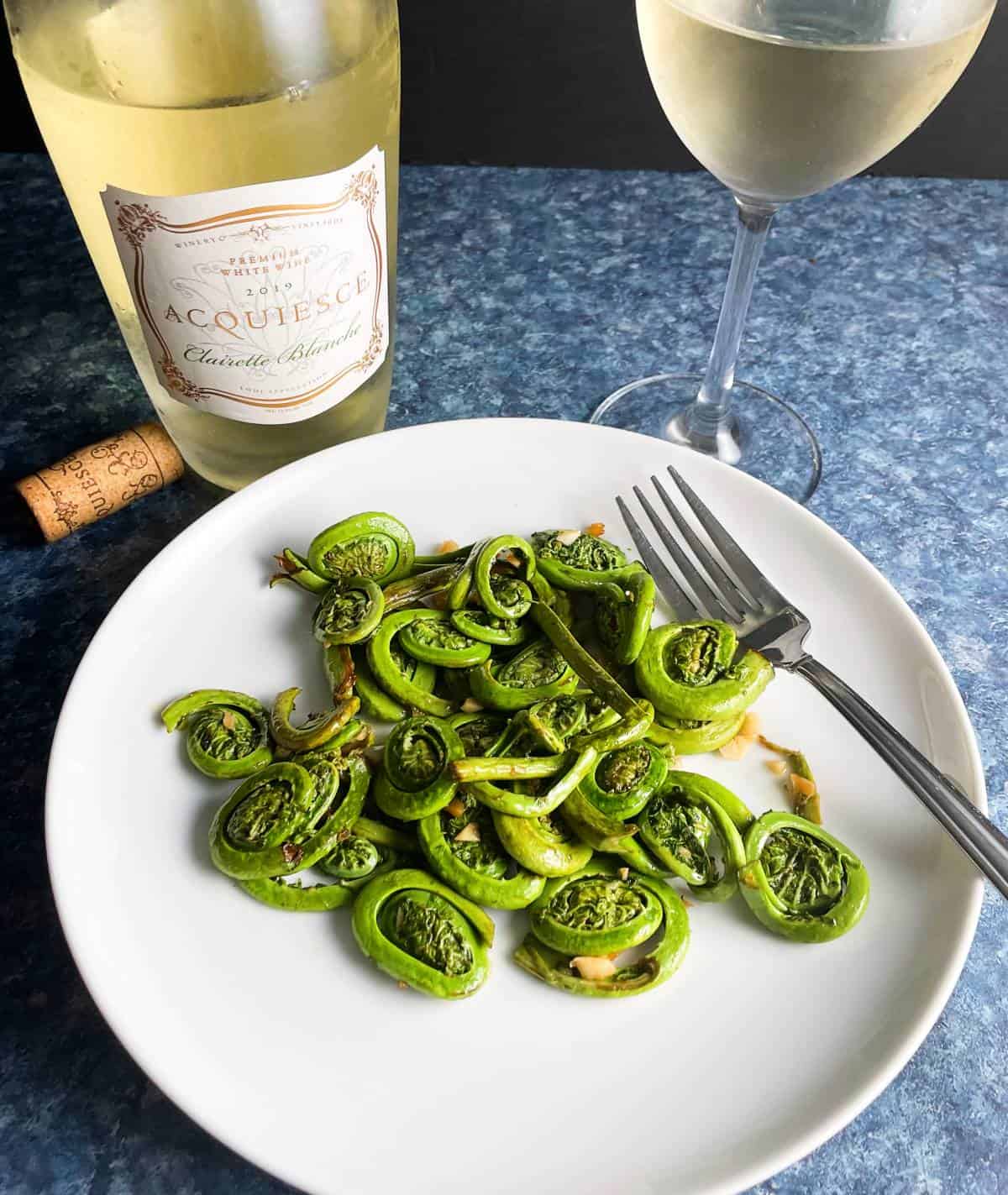
The appearance of fiddlehead ferns at the grocery store is a sign of spring for me. Sometimes this foraged vegetable seems to be in the store for just a few weeks, but sometimes they linger long enough for me to serve up here in early June. So if you find some of these curious shaped vegetables and aren’t sure what to do with them, I serve up the simple recipe for Sautéed Fiddlehead Ferns.
Jump to:
About Fiddlehead Ferns
Fiddlehead ferns are commonly found in the northeastern part of the United States, so it qualifies as a local vegetable for us. They are loaded with nutrients, providing a good source of antioxidants, omega-3 and omega-6 essential fatty acids–see this source for more nutritional information.
I’ve consistently read that the ferns should be boiled first, so that’s what we do here in our recipe. After boiling for 10 minutes, the fiddlehead ferns get sautéed with a bit of garlic and soy sauce for a simple, tasty side dish.
Another favorite side dish this time of year is our Sautéed Arugula with Red Bell Peppers.
Step by step
Below is a visual overview the steps for making the sautéed fiddlehead ferns; click here for the full recipe details.
Prep the fiddleheads. Rinse the fiddlehead ferns, then lay them out on a cutting board.
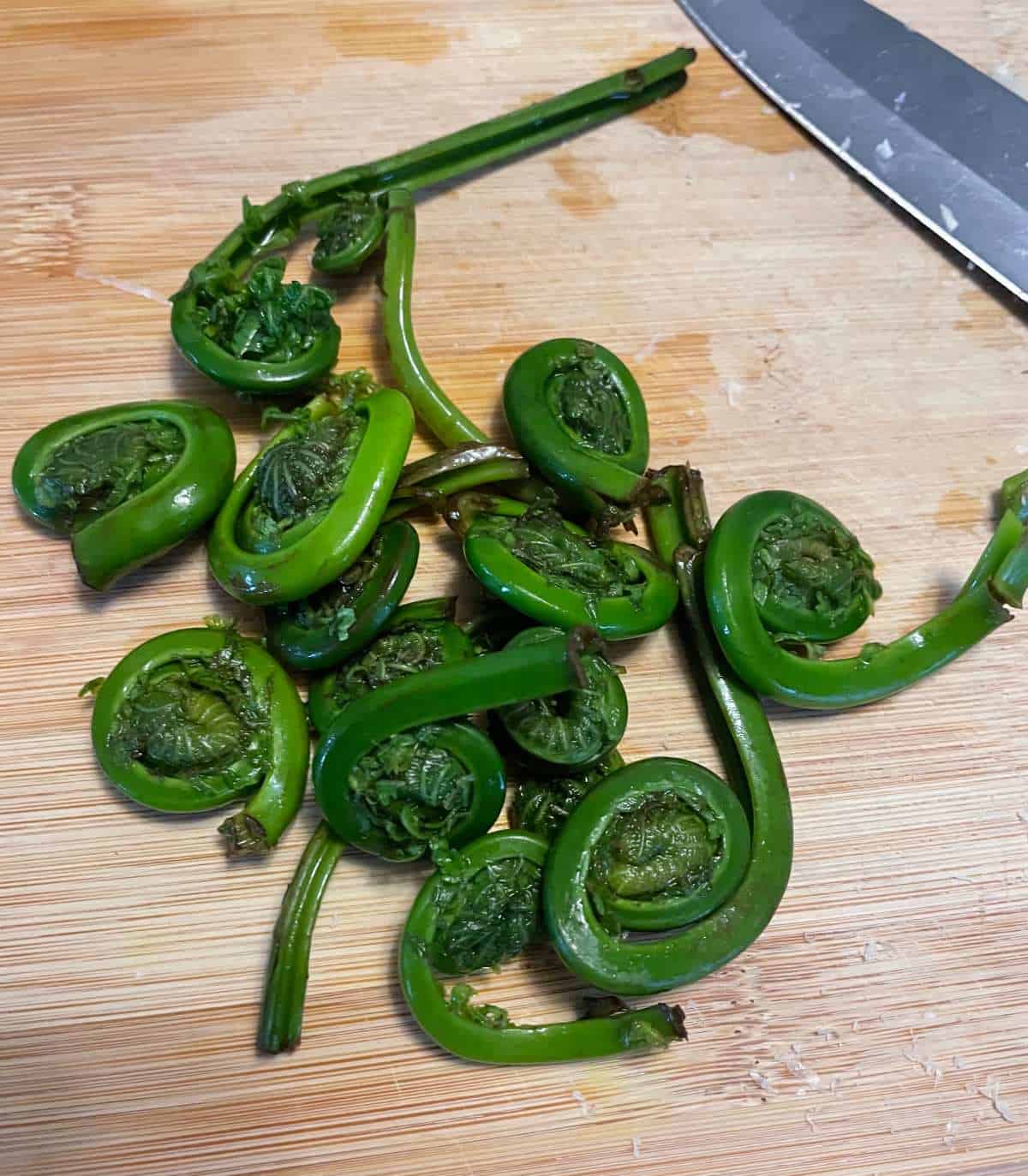
Trim the brown ends off the fiddleheads (see circle below for an example).
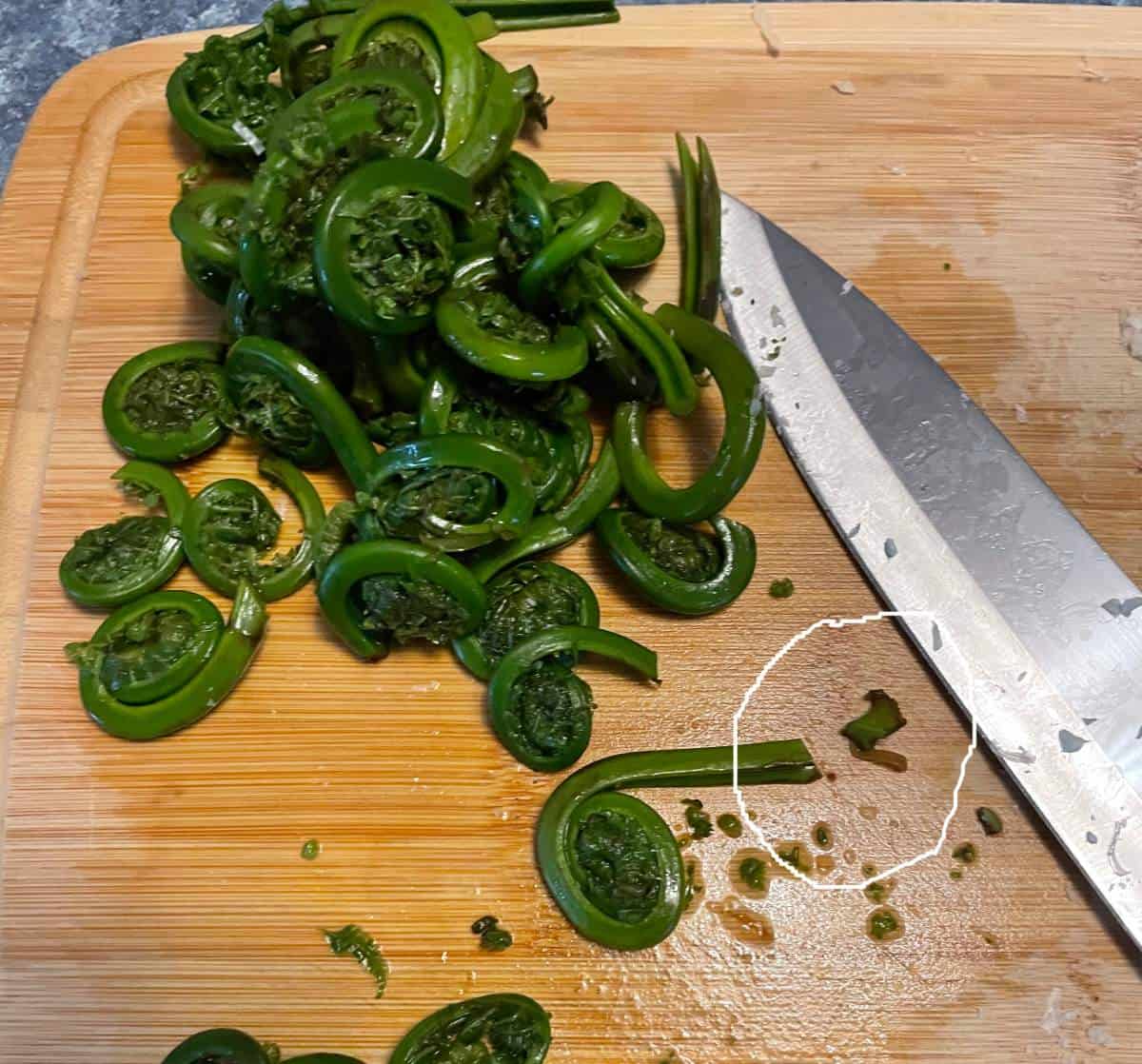
Boil the fiddlehead ferns for 10 minutes. Drain and set aside.
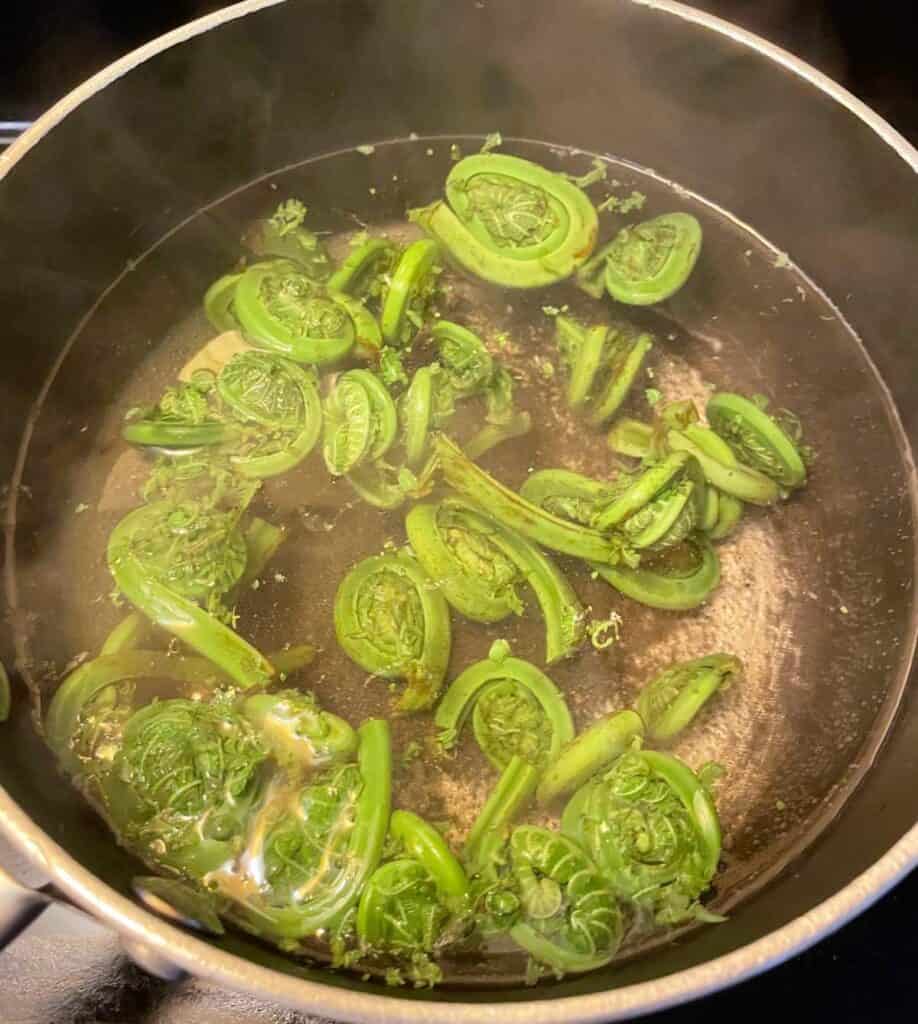
Sauté the garlic with the extra virgin olive oil for about 1 minute. Add the fiddleheads, sauté for 5 minutes. Add the soy sauce toward the end of the 5 minutes.
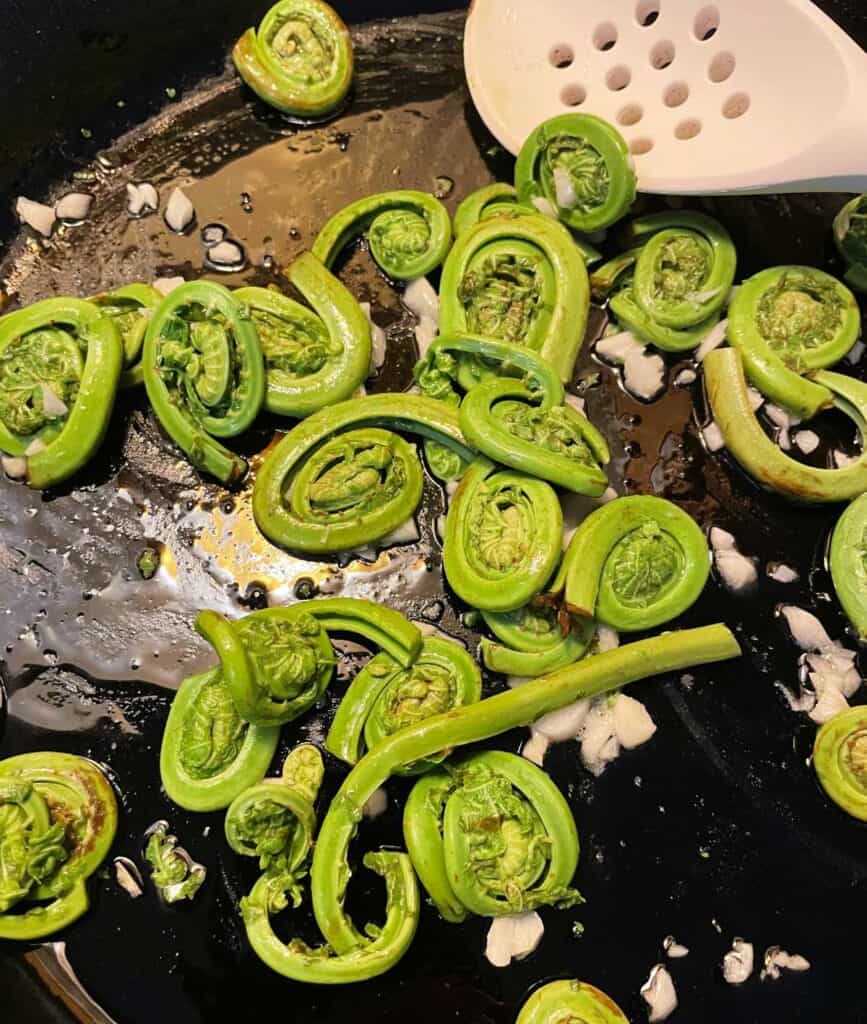
Enjoy!

Frequently Asked Questions (FAQ)
The edible fiddleheads are ostrich ferns in their furled up state prior to growing into a mature plant. They are generally a plant that is foraged in wooded areas of the northeastern US and Canada.
It is generally recommended to boil fiddlehead ferns both for flavor and to avoid any potential issues with toxins found in the raw plant.
Fiddleheads taste a bit like asparagus, although with more of a wild / woodsy flavor.
Fiddleheads typically arrive at farmer’s markets and some grocery stores in the spring. Late April to May are the times we see fiddleheads typically, although we have gotten them in early June.
We recently made another batch of this sautéed fiddleheads and added it to a pasta dish with ricotta cheese and roasted asparagus with mushrooms. It was very good!
Wine pairing
I mentioned fiddleheads taste a bit like asparagus. Though not quite as challenging to pair with wine, the similarity to asparagus means fiddlehead ferns are better served along with a white wine.
For the most recent remake of this sautéed fiddleheads recipe, I turned to a bottle from the excellent wine wine specialists, Acquiesce Winery. I went with their 2019 Clairette Blanche ($28, 13.5% ABV) , a white wine grape with roots in Southern France. The wine was sent as a complimentary sample from the winery.
The Acquiesce Clairette Blanche has honeysuckle on the nose. Cantaloupe fruit and anise notes on the palate. Delicate mouthfeel. Good acidity.
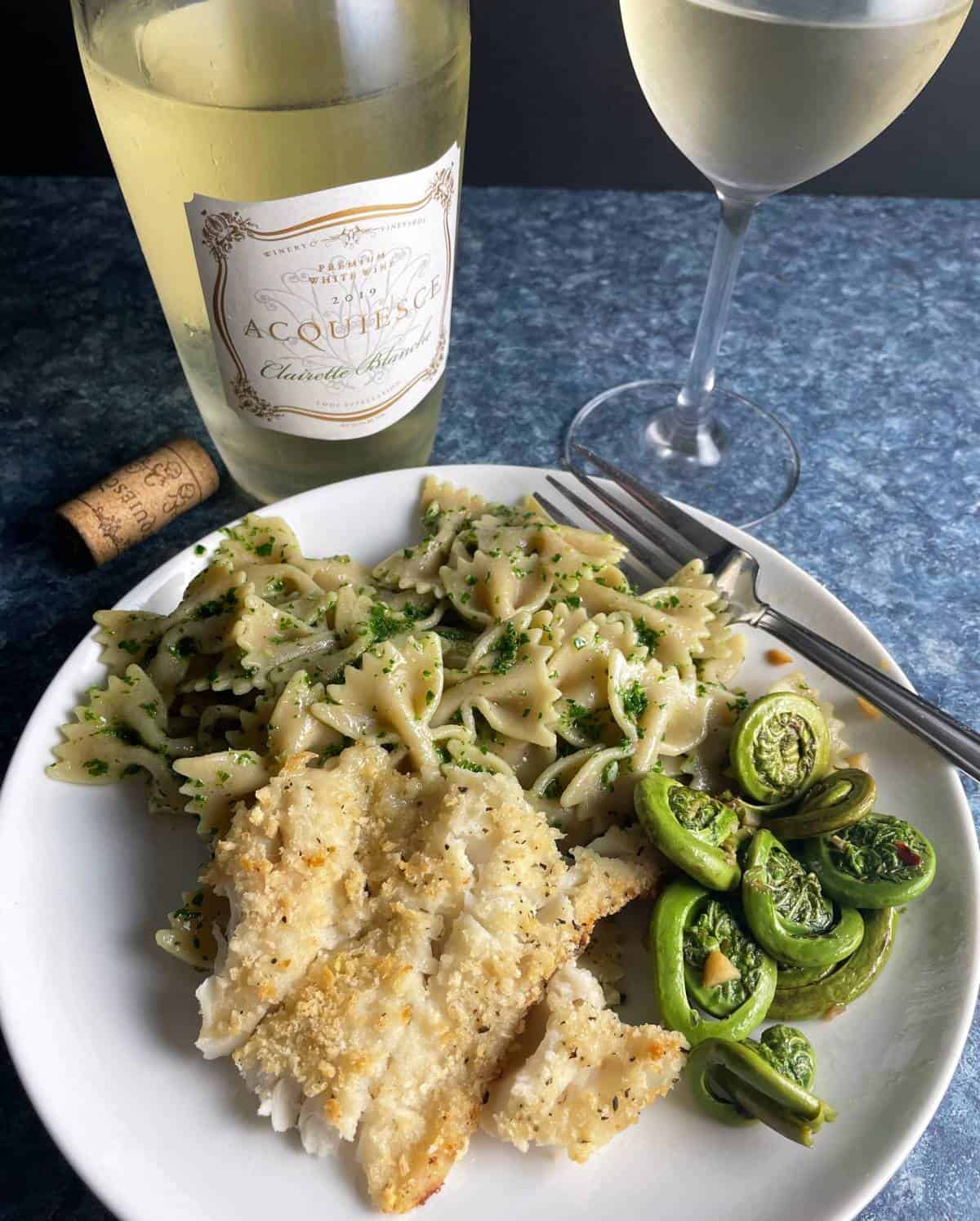
We served the sautéed fiddlehead ferns with baked haddock and a side of pasta with kale pesto. The nuanced flavor profile and acidity of the Clairette Blanche made it a very good pairing for the fiddleheads as well as the kale pesto. The light, flavorful style of the white wine makes it a nice match for white fish, too.
I realized only after putting this meal and pairing together that I’d openened another Acquiesce wine, their Bourboulenc Blanc, to serve with the haddock and kale pesto pasta recipe. Clearly Acquiesce wines are a winning match for that meal!
About Acquiesce Winery
Acquiesce Winery is located in the Lodi, California wine region. The grapes for the Clairette Blanche are estate grown from the Mokelumne River sub-appellation. They specialize in white wine grapes, in a region more known for its reds. The focus on whites from Lodi, and the single Rhone grape varietals they produce with such precision, make it a winery to seek out for sure.
I covered a bit more about Acquiesce Winery in another post when I paired their Acquiesce Viognier with our Easy Korean Chicken Wraps.
Acquiesce follows Lodi Rules for sustainable wine growing.
Other pairings
We previously enjoyed this sautéed fiddlehead ferns recipe along with this grilled swordfish pasta dish.
We served that with a white wine from Campania. The subtle 2012 Vadiaperti Greco di Tufo worked nicely with the fiddlehead ferns as well as our swordfish. That said, most light to medium bodied white wines should work pretty well with the fiddlehead ferns. So enjoy your ferns along with a glass of white wine!
PrintRecipe card
Sautéed Fiddlehead Ferns
Fiddlehead ferns are a sign spring has arrived. This simple sautéed fiddlehead fern recipe is an easy way to enjoy the foraged vegetable.
- Prep Time: 5 mins
- Cook Time: 16 mins
- Total Time: 21 mins
- Yield: 3 servings 1x
- Category: Side dish
- Method: sauté
- Cuisine: American
- Diet: Vegan
Ingredients
- ½ lb fiddlehead ferns, rinsed
- 2 cloves garlic, minced
- 1 tbsp extra virgin olive oil
- 1 ½ tsp soy sauce
Instructions
- Prep the fiddleheads: After rinsing, trim any brown ends from the fiddlehead ferns.
- Boil the fiddlehead ferns for 10 minutes. Drain thoroughly and set aside for a couple minutes.
- Heat the olive oil in a skillet. Add the garlic, and sauté for about 1 minute.
- Sauté: Add the fiddlehead ferns to the skillet. Sauté for about 5 minutes, stirring in the soy sauce close to the end of the 5 minutes. The fiddlehead ferns are ready to serve with the rest of your meal.
Notes
- Trim the brown ends off the fiddlehead ferns before cooking.
- Fiddleheads should be boiled before sautéeing.


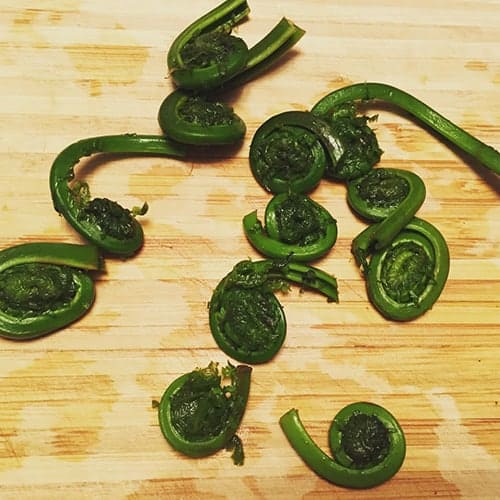
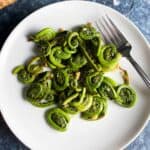
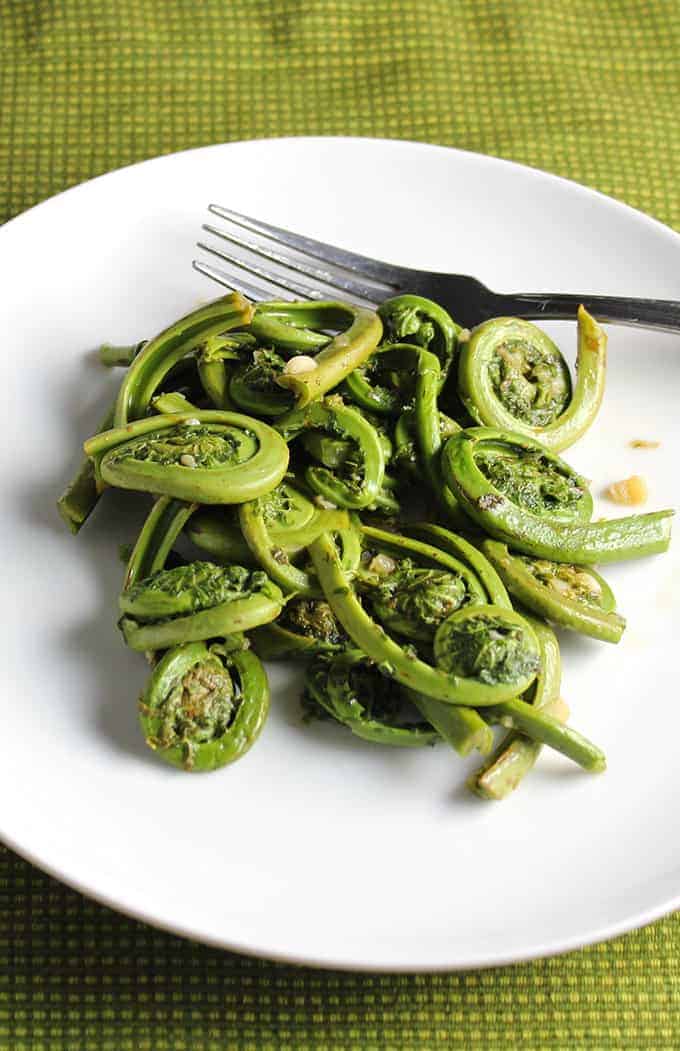
Catherine
Dear David, I must admit I have never had fiddlehead ferns before, but they sound wonderful sauteed like this. Are they like broccoli rabe? A wonderful and elegant dish my friend. Take care, Catherine
Cooking Chat
Thanks for the kind words, Catherine. They are a bit like broccoli rabe but a bit more mild I would say.
Shashi at RunninSrilankan
I’ve never had Fiddlehead ferns before and I am so intrigued! I hope I run into these at some sort of specialty store here in the South!
Cooking Chat
It sounds like they are particularly abundant in the Northeast but I know from hiking in the South there are plenty of ferns there…you might find a different variety locally than we have here.
Cyndi - My Kitchen Craze
I got to say I’ve never heard of fiddlehead Ferns before. If I saw them at the grocery store I would most likely pass them up but because you say they taste more along the lines of an asparagus then I think I need to try them asap! 🙂 Thanks for introducing me to a new food!!
Cooking Chat
always fun to find new foods!
Andrea Wyckoff
I love picking wild fiddleheads in the spring! And I agree they do remind me of asparagus! Love your photos too!
Cooking Chat
Thanks Andrea! I haven’t had the chance to pick my own fiddleheads yet, must be neat to do that.
Jill BARTH
So whimsical. I’d love to try these delights!
Cooking Chat
Thanks Jill! Nice easy spring side.
Sylvie
I wish I could find fiddlehead ferns out here!
Cooking Chat
I get them at Whole Foods, but believe they can be found in New England, where we are.
Harold
Fiddleheads grow along waterways. look for them on ground that is usually under water during the spring runoff. frost will damage them in the spring, but they will regrow a new head of fiddles in a few days. you can go back where you “picked it clean” a few days later, and it will look like you were never there, new fiddleheads will come up again. This being said, if the ground is in the riverbed during the spring, you can actually find fresh fiddleheads well into June on ground that was under water until the spring runoff ran dry and the river is down to its summertime lows. islands that are under water until June will often have abundant fiddleheads on them, and are often called “fiddlehead islands”. there may be a brown leafy sheath on the fiddles that is sometimes coppery, but it can be blown off or removed by unfurling the curls, although, they are not quite so photogenic after you do that, but if the brown bothers you, it comes right off. once you clean them, they should be rinsed and strained. they can be blanched and frozen for winter, and they can be canned, if you know what you are doing. we enjoy them year round this way. you can pick a five gallon pail in a good spot in less then an hour. a good free standing pack basket is the best thing, as it can be fairly heavy to pack out, if you do not come and go by canoe. Just a few thoughts from a Mainah who enjoys his fiddleferns.
Cooking Chat
Thanks for all the good info on fiddleheads!
Harold
I forgot to mention, try them steamed, they retain more of their flavor that way, and they will have better “tooth” than if you boil them. they are great with butter and salt and pepper, but if you put some of your secret stash of good balsamic vinegar on them, you will have a new favorite food. wild strawberries are sometimes out by the end of fiddlehead season, and they go well for a desert. some enjoy them with white vinegar, but i like them with balsamic so much better.
Harold
Fiddlehead quiche is a thing as well. I like it a lot, but have never made it myself, so i do not have a recipe that I can personally recommend.